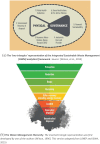The nine development bands: A conceptual framework and global theory for waste and development
- PMID: 34525879
- PMCID: PMC8485264
- DOI: 10.1177/0734242X211035926
The nine development bands: A conceptual framework and global theory for waste and development
Abstract
Solid waste management (SWM) is an essential utility service. More than two to three billion people worldwide still lack basic services, whereas some countries are already moving beyond SWM towards waste and resource management (WaRM) and a circular economy. This paper sets out a novel conceptual framework and global theory of waste and development, providing a road map, allowing a country or city to locate their current position and plot their way ahead. We identify nine development bands (9DBs) with significant commonalities in terms of critical challenges and developmental pressure points. DB1-DB4 reflect stepwise improvement towards the new baseline of meeting the SDG 11.6.1 indicators of universal collection and management in controlled facilities (DB5). Countries can then choose to move towards environmentally sound management and the 'reduce, reuse, recycle' (3Rs) (DB6-9), with an ultimate aspiration of 'zero waste'. We test the 9DBs conceptual framework against historical journeys of higher income countries. The main application will be in low- and middle-income countries striving towards SDG 11.6.1, where it fills a key gap in the practitioners' toolkit by enabling initial framing/scoping of the problem and smarter interventions to be designed and sense checked. Key insights include targeted governance/institutional reforms, appropriate and affordable systems/technology and adapting solutions to a diversity of local needs and realities.
Keywords: Municipal solid waste management; Sustainable Development Goals; analytical toolkit; controlled recovery and disposal; developing countries; model or framework; waste collection coverage; waste governance and institutional reform; waste history.
Conflict of interest statement
Figures




References
-
- Abarca L, Thurn R. (2013). Strengthening capacities for an integral waste management system in Bo City – Waste management plan 2020. Report by WASTE for WHH and UKaid. [Online] Available at: https://www.researchgate.net/publication/273122048_Strenghtening_capacit... (accessed 15 January 2021).
-
- Al Sabbagh MK, Velis CA, Wilson DC, et al.. (2012). Resource management performance in Bahrain: a systematic analysis of municipal waste management, secondary material flows and organizational aspects. Waste Management & Research 30(8): 813–824. - PubMed
-
- Allesch A, Brunner PH. (2014) Assessment methods for solid waste management: A literature review. Waste Management & Research 32(6): 461–473. - PubMed
-
- Aparcana S. (2017) Approaches to formalization of the informal waste sector into municipal solid waste management systems in low- and middle-income countries: Review of barriers and success factors. Waste Management 61(3): 593–607. - PubMed
-
- Asefi H, Shahparvari S, Chhetri P. (2020) Advances in sustainable integrated solid waste management systems: Lessons learned over the decade 2007–2018 (Review). Journal of Environmental Planning and Management 63(13): 2287–2312.
MeSH terms
Substances
LinkOut - more resources
Full Text Sources
Miscellaneous

